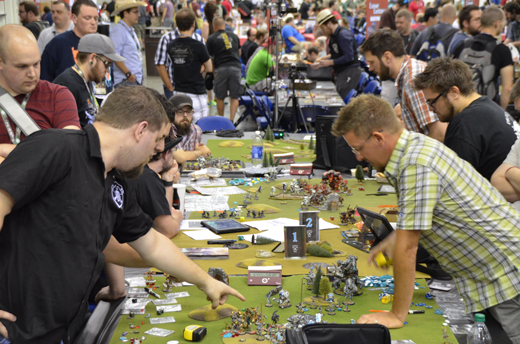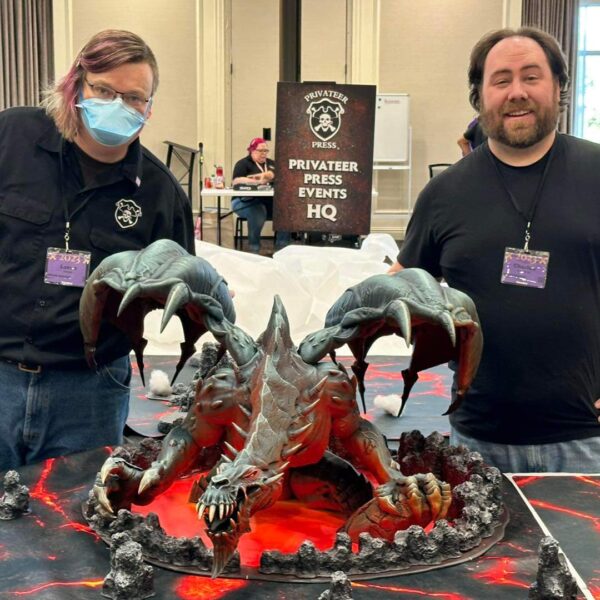
Running Demos For New WARMACHINE Players
By Chris O.
Hello again, gamers! I’m back to talk about bringing new players into WARMACHINE and guiding them as they take their first steps onto the battlefield. Today, I’m going to go through some tips for running demo games.
Setting Up
As with my previous Insider about using the Duos format as a teaching tool, there will naturally be differences between the models and terrain that you and your friends have compared to what I talk about here. So, take these as guidelines and adapt them to the resources and time you have available; as long as your novice player has a good time and learns a little more about WARMACHINE, you’ve run a successful demo!
One thing to keep in mind when running a demo is that no two people are going to come into a demo with the same experiences or level of knowledge. I’ve written most of these tips assuming that the person you’re demoing to is basically a total wargaming novice; if they’ve played other wargames or even previous editions of WARMACHINE, they may be comfortable learning at a different pace than what I describe below.
Models
Personally, I like to have some demo forces prepared ahead of time in case I run into someone who is interested in trying the game. If you don’t, that’s okay—you can always put together a demo with whatever models you happen to have on hand!
If you’re playing at a store or a club, you can talk to the owner/operator about having shared demo forces that anyone can use, or you can transport them with the rest of your models when you come to game nights. Some stores I’ve frequented have even had demo forces available that are already painted by volunteers from their community, which can be a fun community-building exercise.
In addition to the model selection tips from the Duos for Novices Insider, here are a few extra guidelines I personally like to follow when setting up demo forces:
- Try to make sure the demo force uses the same resource mechanic (focus/fury/essence) as your main force (or other demo force). You’re going to be explaining a lot of mechanics to your new player, and it can save some headaches for both of you if you aren’t describing the differences between focus, fury, and essence, too.
- This is one reason why Infernals can be a difficult Faction to use for demos: it is the only Faction that uses essence. Unless the novice player is already planning to play them, I would advise leaving Infernals out of demo games.
- Having printouts for your demo forces can help keep things moving if the new player isn’t able to install the WARMACHINE app right away. In the future, you’ll be able to print the rules for your demo force directly from the app, but in the meantime, you can find printable sheets for demo forces and Command Cards on the Community Hub here.
- If you’re looking to build a demo force with some infantry in the style of the upcoming Necrofactorium Command Starter, rather than the traditional Leader + two Cohort models, you can use the model selection suggestions from the Duos Insider as a starting point.
- Remember that the point of the demo isn’t to have balanced forces; it’s to give prospective players a good sample of how WARMACHINE plays. It’s fine if your two forces aren’t exactly the same points or if one has a slight advantage over the other, since neither player will be playing strictly to win.
Terrain
I try to keep terrain relatively simple for demo games so that you can focus on the models themselves. A handful of forests, walls, and obstructions are usually enough to teach the importance of terrain and line of sight to a new player. Set up a 3″ by 3″ space and arrange the terrain so there are few clear sight lines all the way across the table but some extra space to maneuver compared to a regular game against another veteran player.
Dragon’s are a Don’t for Demos!
Running the Demo
Now that we have all the prep out of the way, let’s get into the nitty gritty of the actual demo experience. I take a lot of inspiration for my demos from the typical video game tutorial: introduce mechanics in stages of increasing complexity and don’t provide information the player doesn’t need yet. A first-time player doesn’t need to know how to resolve melee attacks or spend focus to boost on the first turn, so don’t worry about teaching them that until it comes up in gameplay.
One thing I want to note before I get into the round-by-round breakdown is the idea of making mistakes. In my opinion, you should try to help your novice player avoid rules mistakes but take a lighter hand on tactical mistakes. Try to avoid letting them do something like throw a light warbeast with a gun into melee with a heavy warbeast, but it’s okay if they make minor mistakes like allocating an extra focus to a heavy warjack that has no way to use it this turn. The former is a mistake that will likely result in the feeling they wasted the light warbeast or even that you purposefully didn’t tell them something so you could win. The latter is almost always pretty low impact and serves to show the importance of planning their allocations, but it isn’t going to diminish the game experience overall.
Round 1
Round 1 should focus on identifying models and covering the basics of movement, resources, and upkeep spells. This is almost always the most structured part of the demo. Here’s the way I like to go through the first turn:
- Walk through the phases of the turn, starting with Maintenance. Make sure to point out any rules that trigger in the Maintenance or Control phases such as Apparition.
- Explain ARC, CTRL, and Power Up (if playing focus armies) during the Control phase. Don’t worry about allocating focus this round.
- Take a look at the novice player’s spell card and broadly explain spells and give tips on spells that they might like to cast on turn 1. Don’t worry about explaining the effects of spells that they have no reason to cast yet.
- As you activate your own models, talk about what each model does and why you’re moving them the way you are. Give the novice player advice but don’t run the list for them; let them make their own decisions with the advice you give.
- If you went second, try to set your own forces up in a way that will let the novice player start making attacks against them next round.
By the end of Round 1, I make sure I’ve covered the ARC, CTRL, and SPD stats, model activations, spell casting, and the basics of movement and terrain.
Round 2
The goal this round is to have the novice player start making attacks of some sort. You should continue narrating decisions you make and giving the novice player help as needed, but give them a chance to go through the steps themselves if they seem to have a handle on them. If you took the first turn, this is your chance to make sure you create some opportunities for the novice player to make attacks this round.
Before your novice player begins activating models, make sure you cover upkeeping spells and either leeching fury or allocating focus. Help them identify models that are likely to make attacks this turn and allocate resources accordingly. This is where you can identify spells, animi, or abilities that they might want to use before making attacks and talk a bit about order of activations.
By the end of Round 2, your novice player will have made some ranged or arcane attacks. Here I try to make sure I cover the AAT, RAT, DEF, and ARM stats, ranged weapon profiles, cover and concealment, recording damage, and any special effects that come up.
Rounds 3 & 4
With ranged and arcane attacks covered, you should be trying to get into melee attacks during the next round or two, depending on the models you’re using. Try to set up your own models to be charged first, if you can, or fail to destroy the novice players models, if they do make the first charge. Try to avoid a situation where their best melee model never makes a melee attack for the whole demo. I also like to set them up to make power attacks if possible; I’ve found that making their first Throw power attack is a real highlight of the demo for a lot of people.
By the end of Round 4, you’ll likely have fewer models on the table and have covered MAT, buying attacks, Dual Attack, and engagement. You’ll almost certainly have covered Feats by this point as well, since they will come up at whatever turn is appropriate for that particular Feat.
Finishing the Game
By now, you should have a good idea of how the demo is progressing, and you can finish the game in the next few rounds. Remember that the most important thing is to make sure the novice player is having fun, no matter who ends up winning (though I definitely set up chances for them to win whenever possible). By the end of the demo, the novice player should have a broad idea of how a game of WARMACHINE plays and have had lots of opportunities to do cool things with models they controlled. If they’re already talking about other moves they could have made or models they want to try, you know you’ve run a great demo!
Growing from Here
The hope with any demo game is, of course, that the novice player wants to keep playing, and there are lots of ways you can help them grow into the WARMACHINE community. As they start to grow their collection and play more games, you and other members of your local community are going to be their best resource for guidance.
It’s important to remember that everyone is going to grow into the hobby and game at their own pace and with their own preferences. As you move from demos to teaching games and regular play with a novice player, make sure you’re asking them about how they like to learn and what their goals are. Some players love playing hard games and learn by losing; others might prefer more guidance and advice during games. Your novice players may want to play small games for a while, or they may want to start playing in Steamroller tournaments as soon as possible. In all likelihood, they will exist somewhere between these examples—and the only way to find out is to ask.
Ultimately, the best way to make sure someone sticks around with a new hobby game is to make sure they are getting what they want out of it; don’t assume they want to learn the same way you or anyone else did. Guiding new players can take patience, but it’s extremely rewarding to watch them grow into their own as players and hobbyists.
As always, the Community Hub is a great place for new and veteran players to find resources or to ask questions!
Until next time, I’ll see you on the tabletop!
The post Running Demos For New WARMACHINE Players appeared first on Privateer Press.


